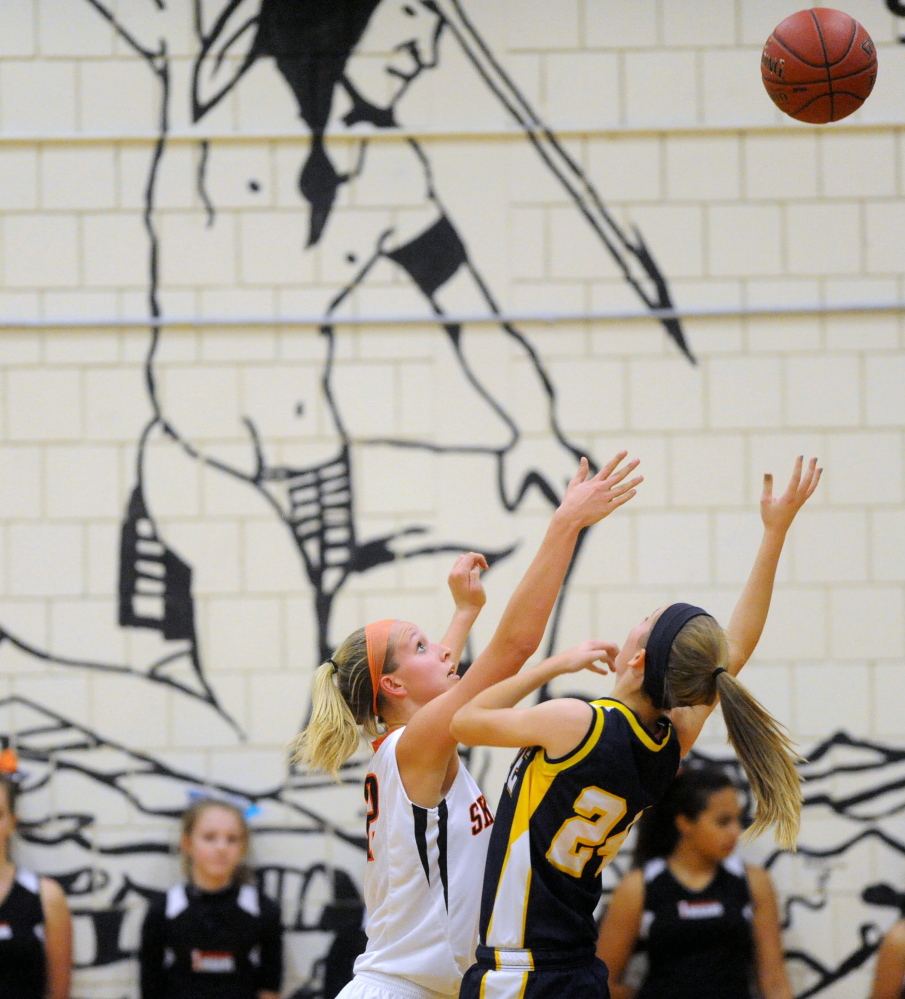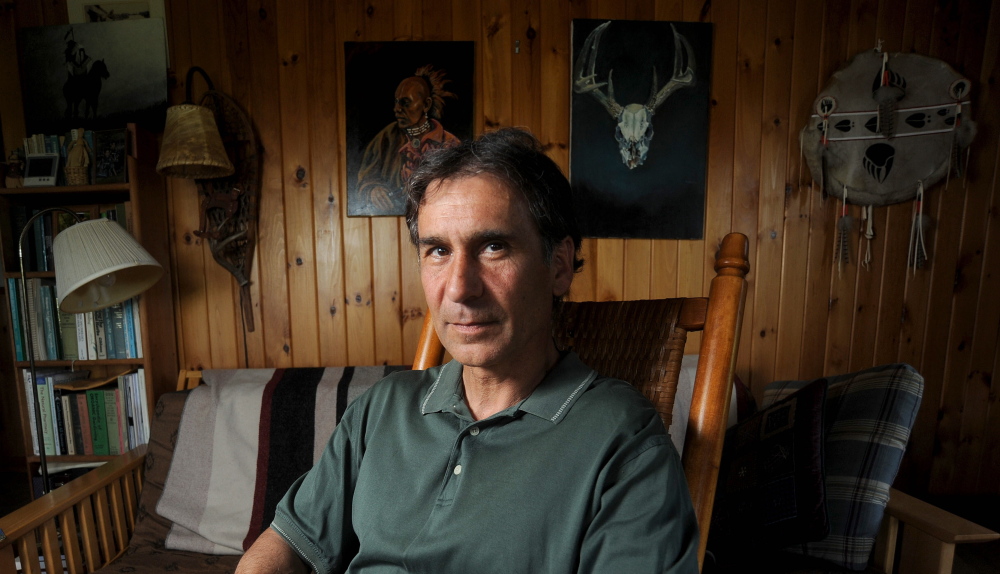The meetings in Wiscasset were sometimes contentious, with residents “very dug in about this issue.” John Dieffenbacher-Krall expected that.
It was the fall of 2010, and Dieffenbacher-Krall, executive director of the Maine Indian-Tribal State Commission, was working to get Wiscasset High School to change its nickname from the Redskins to just about anything else. One man, boisterously against any change, announced he was born a Redskin, was a Redskin when he attended Wiscasset, and would die a Redskin.
Paul Bisulca, a member of the Maine Indian-Tribal State Commission, countered with a question: If you were on Indian Island and stopped to ask for directions, would you roll down your window and yell, “Hey, Redskin!”?
“In our minds, there’s no debate,” said Dieffenbecher-Krall. “It’s such a horrific nickname.”
The following spring, Wiscasset High School officially dropped the nickname Redskins and became the Wolverines.
Indian sports nicknames are in the national spotlight because of mounting pressure on Washington Redskins owner Daniel Snyder to change the nickname of his NFL team. On Thursday, the executive director of the NFL Players Association said the Redskins team name conveys “racial insensitivity,” and an attempt to drum up support for Redskins President Bruce Allen’s defense of the name backfired on the social media site Twitter, with the hashtag – #RedskinsPride – prompting a flood of complaints.
In Maine, a number of high schools and junior high schools have dropped Native American nicknames in recent years.
But three high schools in Maine – Skowhegan Area High School, Nokomis Regional High School in Newport, and Wells High School – still use nicknames and imagery related to Native Americans considered offensive. Wells and Nokomis are the Warriors, Skowhegan is the Indians.
Wells is in the process of phasing out Native American imagery to become a more neutral Warriors.
“It’s a process that has been ongoing,” said Ellen Schneider, Wells superintendent of schools. “It’s a non-issue in our community. We’re trying to do this quietly.”
‘NO REASON TO BE OFFENSIVE’
The biggest supporter of mascot change in Maine is Ed Rice, who wrote a biography of Louis Sockalexis, the Penobscot who played professional baseball for the Cleveland Spiders at the turn of the 20th century. Rice, a journalism instructor at the New England School of Communications in Bangor, spent years trying to get the Cleveland Indians to abandon the caricature mascot that adorns their baseball caps, the cartoonishly grinning Chief Wahoo.
“I was tilting at the windmill that is Chief Wahoo in Cleveland,” Rice said.
In recent years, Rice streamlined his fight to focus on removing Native American mascots from Maine schools. In 2010, he and Dieffenbacher-Krall hosted a symposium at the Bangor Public Library, to which they invited representatives of each of the Maine schools that use Native American mascots to discuss the issue.
“We only had to invite nine schools,” Rice said.
Now, there’s just the three. Some schools, including Southern Aroostook High School and Fort Kent High School, adopted a generic Warrior mascot, just as Wells is doing.
“Sure, you can find Native Americans who are fine with this. There are more who are embarrassed,” Rice said. “There’s no reason to be offensive to anyone.”
The first Maine school to change was Scarborough High School, in 2001. The school dropped Redskins in favor of Red Storm. Husson University eliminated the Braves nickname and became the Eagles. More recently, Wiscasset High School and Sanford High School eliminated the Redskins nickname. Wiscasset teams are now known as the Wolverines, while Sanford athletes are the Spartans.
In Old Town, the nickname Indians was dropped and Coyotes was adopted.
“It was very much the right thing to do,” said Barry Dana, who was chief of the Penobscot Nation from 2000 to 2004. “They had a long conversation with the native people.”
Indian mascots lower the self-esteem of American Indian students, according to Stephanie Fryberg, a visiting professor of psychology at the University of Washington. Fryberg conducted studies in which Indian high school students were exposed to Chief Wahoo, Disney’s Pocahontas, and Indian stereotypes.
“What we found was, the images decreased self-esteem more than the negative stereotypes,” Fryberg said.
Fryberg also found that the Indian students exposed to the images of Chief Wahoo and Pocahontas also had felt lower community worth than those who had not been exposed to the images.
“We’ve replicated the effect several times,” said Fryberg, a member of the Tulalip Tribes of the Pacific Northwest.
In her third study, Fryberg went to Haskell Indian Nations University, in Lawrence, Kansas, the only four-year university in the nation predominantly attended by American Indians. There, students were exposed to Chief Wahoo and Chief Illinewek, the former mascot of the University of Illinois, to expose them to a non-caricature mascot. Haskell also has an American Indian mascot, Fryeberg said.
“All three had an equal negative effect,” Fryberg said.
There are very few representations of American Indians in the national media, Fryberg said, and a great number of those that do exist are negative.
“The media is a powerful communicator,” Fryberg said.
NAME CHANGE OPPOSITION
People involved in all the recent nickname changes said the process was long, and often contentious.
“There was a fairly significant opposition to changing,” said Gregory Potter, Wiscasset’s school superintendent during the transition. “The school board did vote for the high school to change (the nickname). That seemed to be the prevailing opinion.”
Potter is now superintendent of Newport-based Regional School Unit 19, where Nokomis is the high school. While some schools in RSU 19, including Corinna Elementary School and Etna-Dixmont School, have retired the Indians nickname in recent years, Potter said there has been no significant discussion to change the Warriors mascot at Nokomis.
“No one has formally approached me or the school board,” Potter said. “There is no discussion, and there has not been one planned. There’s a great deal of pride around Nokomis – their very responsible, respectful use of the Warrior.”
In recent years, efforts have been made by Nokomis administrators to prevent students from attending school sporting events in war paint.
“The Nokomis fix is as simple as it gets,” Rice said. “Do what those other schools did and become generic Warriors.”
No matter the intention and respect hoped to convey, the nicknames are still offensive to Maine’s Native Americans, Dana said.
Dana, who now lives in Solon, was involved in the discussion when Old Town High School dropped the Indians nickname.
“When they say, ‘We’re honoring you,’ that I actually agree with them on. I’m trying to give them credit,” Dana said. “They say, ‘We’re honoring you,’ to which I reply, ‘That’s sounds really good, but if the end result is perpetuating of a stereotype, that’s no longer appropriate.’ ”
‘SOMETHING TO RALLY AROUND’
Sanford retired the Redskins mascot in the spring of 2012, officially becoming the Spartans for the 2012-13 school year. It was a long, often difficult discussion, Superintendent David Theoharides said.
But he said it was worth it.
“It’s been the greatest thing that’s happened,” Theoharides said. “Spartans has really just exploded.”
Sanford’s school board began the process a decade ago, when it decided the school couldn’t use Native American symbolism in regard to the Redskins nickname. Students could not dress in native clothes and war paint, and things like war yelps and tomahawk chop gestures with the arm were banned.
It was, Theoharides said, putting off the inevitable. The nickname change was ultimately initiated by the students, he said.
“All our uniforms had was a giant S,” Theoharides said. “The kids made the difference. They said, ‘Give us something to rally around.’ “
Sanford students chose Spartans in a schoolwide vote for a new mascot. Redskins was not scrubbed from Sanford’s history, as if it never existed, nor will it be, Theoharides said. Banners in the school gymnasium that feature the Redskin nickname remain.
“Nobody insisted we take them down. We changed the nickname. That doesn’t mean we destroy everything,” Theoharides said.
Throughout the process in Sanford, all meetings with Maine’s tribal leaders were civil and productive, Theoharides said.
“They were very much united,” he said. “They didn’t yell. They didn’t scream. They just said, ‘This hurts us.’ “
That’s the approach Dana will continue to use.
“You can’t walk up to someone with the intent of having a conversation by slapping them in the face,” Dana said. “That won’t work.”
WHAT’S IN A NAME?
While the Maine Indian-Tribal State Commission was a key in the move to change the nickname in Wiscasset and Sanford, Dieffenbacher-Krall said the commission is not actively involved in any movement to get Skowhegan, Nokomis or Wells to change.
Even so, Dieffenbacher-Krall said “we’re supportive of any efforts” to bring about nickname changes.
At Skowhegan, the Indian mascot goes far beyond the high school’s borders. Native American imagery is found all over the town. Skowhegan’s official seal, found on the town website, includes an Indian head. In downtown Skowhegan, a giant sculpture of a Native American stands. Designed and sculpted by Bernard Langlais, a sign in front of the Skowhegan Indian reads: “This sculpture is dedicated to the Maine Indians. The first people to use these lands in peaceful ways.”
“It’s meant to show respect to the heritage of the community,” Skowhegan Superintendent of Schools Brent Colbry said of the high school’s nickname. “I believe I can say that the community, as a whole, sees the use of the Native American Indian symbol as one of pride and respect and not a negative.”
Several years ago, the School Administrative District 54 board in Skowhegan did discuss the nickname with local Native American residents, Colbry said. While they did not consider the nickname offensive, they noted the image painted on the school’s gym wall was that of a Plains Indian, native to the Midwest.
Colbry said the image was redesigned to become representative of the Indians native to central Maine. However, on the sign at the entrance to Skowhegan Area High School, the Indian depicted is dressed as a Plains Indian.
Rick York grew up in Skowhegan, played sports for the high school, and is now head coach of the Skowhegan varsity baseball team. York said he doesn’t remember the Indian nickname ever being controversial when he was a student at Skowhegan Area High School.
“Growing up, and in my adult life, it never has been an issue,” York said. “Now it’s a nationwide thing. It’s part of our heritage and it’s part of our name. I don’t know what they’re going to do.”
Fryberg, the visiting professor of psychology at the University of Washington, said there are a few reasons Indian mascots gained popularity. One, the Indian population is small. Two, Indian culture has been romanticized in the United States for a long time.
Whites think of Indians and think of being close to nature, spirituality and wise elders, Fryberg said.
“They don’t want the real story, the contemporary story,” Fryberg said. “Because we romanticize natives, we tolerate this.”
Dana said change will come slowly, and he’s in no hurry to rush it.
“There’s no pressure here. There’s no timeline,” Dana said. “In the end, to totally eradicate any sense of racism, this has to happen.”
Travis Lazarczyk can be contacted at 861-9242 or at:
tlazarczyk@centralmaine.com
Twitter: @TLazarczykMTM
Send questions/comments to the editors.





Comments are no longer available on this story